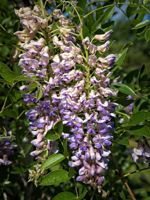Mon-Fri 9am - 5pm Mountain time
Blue Moon Wisteria vs Golden Spice Pear
Wisteria macrostachya Blue Moon
Pyrus Golden Spice
NOT AVAILABLE THIS SEASON - MIGHT RETURN
Blue Moon Wisteria is a striking, flowering vine, and the hardiest of the wisterias. Up to three times in one growing season you can expect showy, fragrant, lavender-blue flowers.
Make sure you plan your site as this vine requires a structure to support its mature weight. Try planting close to a post, trellis, or fence.
Golden Spice Pear produces delicious fruit and has other features that make it a striking accent tree. It is one of the few pears that successfully grows on the Canadian prairies. In late August, small, yellow pears with a slight red overlay will ripen and be ready for a variety of needs, including: fresh eating, canning, jams, and baking. They are slightly sweet with a crisp texture. Come fall, the green foliage transitions to orange, red, or burgundy, adding a burst of color to your yard.
Golden Spice Pear requires upkeep to ensure its survival and longevity. Regular pruning is recommended in late winter or early spring to maintain the oval shape and overall health of the tree. An additional pear or apple tree is required within 150 m (500’) for cross pollination and fruit production to occur.
Blue Moon Wisteria Quick Facts
Golden Spice Pear Quick Facts
Toxicity: can be toxic to cats, dogs, and horses when consumed

